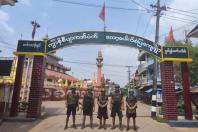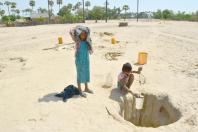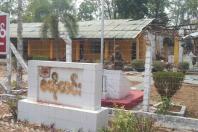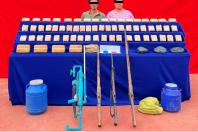
Kathmandu (The Kathmandu Post) - The Pashupati Area Development Trust has begun reconstruction on the unique Vishwarup temple on the premises of the Pashupatinath temple by digging 12 pits and filling them with concrete, inviting the ire of heritage enthusiasts, locals and the authorities.
Built in 1874 by Jung Bahadur Rana, the Vishwarup temple, with its oblong structure topped by a distinctive Mughal onion dome, is one of the most uniquely shaped structures on the Pashupatinath premises. Inside are two massive 12-feet statues of Shiva and Parvati, each with 1,000 heads.
Unfortunately, it suffered massive damage in the 2015 earthquakes when the dome broke and only half of the bottom remains standing. Its repair has been on the cards ever since. Reconstruction has finally begun, but in a manner that heritage conservationists say will destroy the original grandeur of the temple.
“The Trust has taken a unilateral decision that will destroy our ancient heritages,” said Ganapati Lal Shrestha, a heritage conservation activist who was protesting the use of concrete in the reconstruction of the temple on Thursday.
The Trust claims that it will be using the concrete pillars to surround the temple and hold up a truss from the upper section of the temple while reconstruction takes place.
The Vishwarup temple lies within the Pashupati temple premises and hence, is part of the Unesco World Heritage Site. Pashupati was declared a World Heritage Site in 1997 and according to stipulations from Unesco, sites need to maintain their historical aesthetic in order to continue being listed as a World Heritage Site.
Deputy Mayor Hari Prabha Khadgi, along with locals, inspect a pit being dug in the premises of the Vishwarup temple, located in Pashupati, Kathmandu. The temple is finally being reconstructed after being damaged in the 2015 earthquake. Post Photo: Elite Joshi
Furthermore, according to the Ancient Monument Preservation Act 2013, structures over a hundred years old must be preserved in their original design.
Any modifications require the authorisation from the Department of Archaeology.
The Department of Archaeology professed ignorance on what the Trust was doing with the Vishwarup temple when contacted by the Post. “We have not provided any permission to the Trust regarding new construction work at the Vishwarup temple,” said Ram Bahadur Kunwar, spokesperson for the department.
On Thursday, a number of conservationists, activists and journalists, along with Kathmandu Deputy Mayor Hari Prabha Khadgi, had gathered at the Trust’s office in Gaushala to demand clarification. Khadgi leads a five-member ‘inspection team’ that is currently overseeing many aspects within Kathmandu Metropolitan City, including reconstruction, market inspection, infrastructure and waste disposal.
“I came here after I received complaints from locals,” said Khadgi, who directed Pradeep Dhakal, member-secretary of the Trust, to refrain from carrying out any development work without consulting local bodies and the Department of Archeology.
“We will correct our decision,” said member-secretary Dhakal. “We will move forward by coordinating with the department and the metropolis.”
In August last year, the Trust came under fire after it used plain cement concrete—a binding agent in construction materials—in the construction of the 170-metre pavement that leads to the Vishwarup temple from the main pathway through the Sleshmantak jungle—at a cost of Rs2.9 million. The Archaeology Department demanded that the Trust remove the concrete, which it didn’t.
Again, on January 30, a single bench of Supreme Court Justice Purushottam Bhandari had issued an interim order directing the government to stop construction works inside the Pashupatinath premises.
“The Trust has clearly disobeyed the court’s order and it has not learnt anything from its earlier mistakes,” said lawyer and cultural activist Sanjay Adhikari, who was also present at Gaushala on Thursday.
In December 2017, too, the Trust was widely criticised for using concrete in the reconstruction of historic Bageshwori Temple in Pashupati. And just five months ago, the Trust demolished one of the four Shivalayas on the temple premises, upsetting a great many religious and cultural activists.
The Trust has been acting unilaterally ever since its establishment, said Narottam Baidya, a member of Province-3 assembly, who was also present at the protest programme. “We have spoken up many times in the past regarding its behaviour but it has never listened to us,” said Baidya. “It has to be stopped now.”
http://kathmandupost.ekantipur.com/news/2019-02-08/use-of-concrete-in-an...









